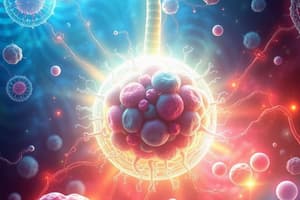Podcast
Questions and Answers
In cellular respiration, which stage occurs in the cytosol of the cell?
In cellular respiration, which stage occurs in the cytosol of the cell?
- ATP Synthesis
- The Citric Acid Cycle
- The Electron Transport Chain
- Glycolysis (correct)
Which metabolic process converts food molecules into ATP?
Which metabolic process converts food molecules into ATP?
- The Electron Transport Chain
- Glycolysis (correct)
- The Citric Acid Cycle
- ATP Synthesis
Where does the citric acid cycle take place in the cell?
Where does the citric acid cycle take place in the cell?
- Nucleus
- Mitochondria (correct)
- Cytosol
- Endoplasmic Reticulum
What is the final stage of cellular respiration?
What is the final stage of cellular respiration?
Which metabolic process produces high-energy electrons during cellular respiration?
Which metabolic process produces high-energy electrons during cellular respiration?
What is the net gain of ATP molecules produced during glycolysis?
What is the net gain of ATP molecules produced during glycolysis?
Where does cellular respiration begin in eukaryotic cells?
Where does cellular respiration begin in eukaryotic cells?
Which organelle is responsible for housing the electron transport chain in cellular respiration?
Which organelle is responsible for housing the electron transport chain in cellular respiration?
What is the primary molecule phosphorylated to form ATP in cellular respiration?
What is the primary molecule phosphorylated to form ATP in cellular respiration?
Which factor does NOT regulate the rate of cellular respiration?
Which factor does NOT regulate the rate of cellular respiration?
In prokaryotic cells, what process is used to produce ATP since they lack mitochondria?
In prokaryotic cells, what process is used to produce ATP since they lack mitochondria?
Which hormone plays a role in regulating cellular respiration?
Which hormone plays a role in regulating cellular respiration?
Study Notes
A Level Respiration
Respiration is a crucial process in the human body, responsible for providing energy through the conversion of food and oxygen into carbon dioxide and water. At the A Level, students study the fundamentals of respiration, including the cellular processes and the various pathways involved in energy production.
Cellular Respiration
Cellular respiration is a series of metabolic processes that convert the energy stored in food molecules into adenosine triphosphate (ATP). The process occurs in three stages: glycolysis, the citric acid cycle, and the electron transport chain.
Glycolysis
Glycolysis is the first stage of cellular respiration, which occurs in the cytosol of the cell. This process converts one molecule of glucose into two molecules of pyruvate, producing a net gain of two ATP molecules.
The Citric Acid Cycle
The citric acid cycle, also known as the Krebs cycle or TCA cycle, occurs in the mitochondria. This cycle completes the breakdown of glucose, producing ATP, carbon dioxide, and high-energy electrons.
The Electron Transport Chain
The electron transport chain is the final stage of cellular respiration. This process occurs in the inner mitochondrial membrane and uses the high-energy electrons produced by the citric acid cycle to generate ATP.
ATP Synthesis
The ATP synthesis process is an essential part of cellular respiration, which converts the energy stored in ATP into a usable form for the cell. This process occurs in the mitochondrion and involves the phosphorylation of adenosine diphosphate (ADP) to form ATP.
Regulation of Respiration
The rate of cellular respiration is regulated by several factors, including the availability of substrates, the concentration of ATP and ADP, and the activity of enzymes. The process is also subject to regulation by hormones such as insulin and glucagon.
Cellular Respiration in Eukaryotic Cells
In eukaryotic cells, cellular respiration occurs in the cytoplasm and mitochondria. The process begins with glycolysis in the cytoplasm, followed by the citric acid cycle and electron transport chain in the mitochondria.
Cellular Respiration in Prokaryotic Cells
In prokaryotic cells, cellular respiration occurs in the cytoplasm. Prokaryotic cells lack a mitochondrion, so the citric acid cycle and electron transport chain do not occur in these cells. Instead, prokaryotic cells use a process called substrate-level phosphorylation to produce ATP.
Mitochondria and Respiration
Mitochondria play a central role in cellular respiration, housing the electron transport chain and producing ATP. These organelles are vital for maintaining cellular energy levels and are present in the cells of both eukaryotes and prokaryotes.
In summary, A Level respiration covers the processes involved in cellular respiration, including glycolysis, the citric acid cycle, and the electron transport chain. These processes provide the energy required by cells through the conversion of food and oxygen into carbon dioxide and water. The A Level curriculum also addresses the regulation of respiration, the role of mitochondria, and the differences between eukaryotic and prokaryotic cellular respiration.
Studying That Suits You
Use AI to generate personalized quizzes and flashcards to suit your learning preferences.
Description
Learn about cellular respiration at the A Level, covering glycolysis, the citric acid cycle, the electron transport chain, ATP synthesis, regulation of respiration, and cellular respiration in eukaryotic and prokaryotic cells. Understand the vital role of mitochondria in energy production.




